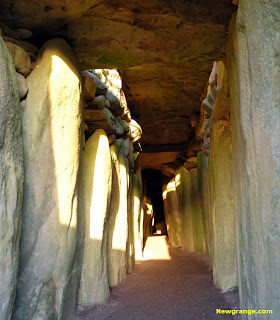New
Grange
Once known as Bru
na Boinne, or Palace of the Boyne, was built in the Boyne river valley
around 3200 BC, by a society of Neolithic people who were clearly
well-organized, well-fed and dedicated to the task at hand. They wouldn’t have
been able, otherwise, to utilize the manpower to construct this enormous
monument , 249 feet across, 39 feet high and covering 1.1 acres of ground,
consisting of alternating layers of earth and stone. The structure wasn't just massive, but, when first built, it was also perfectly aligned with sunrise on the winter solstice. At the end of a passage which is 60
feet long, and lined with large engraved stone slabs, is the most famous feature, where there is a large room with three antechambers and a high,
corbelled (and still water-tight) vaulted roof.
Here, on the solstice--through a
roof box which was only rediscovered during excavations in 1967—enter the first
rays of the rising winter sun. (Irish folktales had always spoken of magical rooms within tumuli where, in the midst of eternal darkness, the sun shone...) When that beam of light penetrates the bee hive chamber, the
winter sun touches the floor just below a great stone engraved with a
tri-spiral, perhaps in honor of the ancient triple goddess, maiden, mother and crone. Spirals, symbols of our life path, carry us on our journey from birth to death to rebirth. The end is also a beginning, as a new seasonal cycle commences again.
The chamber is illuminated for a mere 17 minutes, but, this
year more than 30,000 people entered their names into a lottery to win a ticket
to witness a marvel which has been occurring since before Stonehenge—or the
pyramids--were built.
This winter Sun, seen by the ancient people as “new born”
feels like a miracle to observers today, those of us who watch the skies and mark
the seasons with festival, feast and meditation, much as our ancestors did. From
that day forward, we know that the darkness will begin to recede, and the tide
of light will come in again, until we again reach the summer solstice and the
longest day. Crops will grow, lambs and calves and children will be born. No wonder the early adherents of an odd new eastern religion
called Christianity, hoping for converts, were eager to conflate the birthday
of their "dying" god with the associatively powerful symbol of the rising winter
solstice sun.
Kerb stone symbols
The roof box and megalith with spirals
A modern Stonehenge solstice
Bright Blessings to all, as we welcome a new year!
Learn more at these sites:
Juliet Waldron
http://www.julietwaldron.com







I've been to Newgrange, more than once. I love the passageway and stone symbols, but I think it's terrible how they restored the walls. In doing so, they didn't listen to archaeologists and used modern materials. I think that cheapens the experience of such a magnificent monument.
ReplyDeleteLucky girl...it's on my bucket list. Yes, I understand they used cement, but the white quartz façade is probably authentic, at least as far as my sources on the subject. The crystals and the "color" white were sacred to the Goddess.
ReplyDeleteMy understanding is that the Irish Tourist Board commissioned the restoration, and many disagree with the original archaeologist. In any case, it is a fabulous place to visit, but I'd rather see ruins. I guess I prefer not to try to remake sacred monuments of the past.
ReplyDeleteI find the archaeological ability of the time period amazing. History gives so much emphasis to the Egyptian pyramids and British-centered civilization that we don't know about the advancements made by colonized societies. I wish we knew how they used the space ritually. Thanks for the article, Juliet!
ReplyDelete